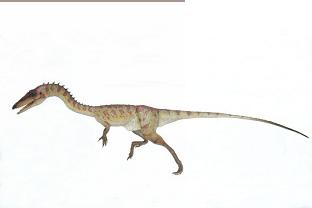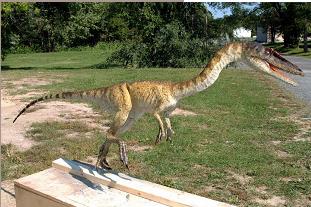click images for larger views

Coelophysis (pronounced SEE-low-FIE-sis) was a small, lightly-built dinosaur that walked on two long legs. This predator was about 9 feet long (2.8 m). It had light, hollow bones (hence its name), a long, pointed head with dozens of small, serrated teeth, three clawed fingers on its hands, and a long neck.
Two types of Coelophysis fossils have been found, 'robust' and 'gracile.' These two forms probably represent males and females.
Two types of Coelophysis fossils have been found, 'robust' and 'gracile.' These two forms probably represent males and females.
WHEN COELOPHYSIS LIVED, CLIMATE
Coelophysis lived during the late Triassic period, roughly 210 million years ago; it was one of the earliest-known dinosaurs. Coelophysis lived in what was then a seasonally dry, desert-like environment, a savanna-type climate perhaps like modern-day Kenya without the grasses (since flowering plants hadn't evolved yet).
DIET
Coelophysis was a carnivore, a meat eater. It may also have been a scavenger. Coelophysis' fossilized stomach remains have been found containing small reptiles, fish, and other Coelophysis bones of different sizes, indicating that it was a cannibal.
BEHAVIOR
Coelophysis probably lived and hunted in packs; this is suggested by the existence of fossil bonebeds of hundreds of Coelophysis (collections of many fossils at one location) found at the Ghost Ranch in New Mexico, USA.
REPRODUCTION
Coelophysis most likely reproduced by laying eggs. Thousands of fossilized Coelophysis skeletons were found at the Ghost Ranch, New Mexico, USA. Many of them contained the bones of young Coelophysis in their abdomens - this evidence showed that Coelophysis either ate its young or gave birth to live young. It is more likely that they were cannibalistic (like many modern-day reptiles) since the tiny Coelophysis skeletons within the adult Coelophysis were not embryos, but young Coelophysis.
LOCOMOTION
Slightly built, long-legged, and very light because of its hollow bones, Coelophysis was a very fast, bipedal runner. Dinosaur speeds are estimated using their morphology (characteristics like leg length and estimated body mass) and fossilized trackways. Coelophysis tracks have been found; the footprint is 4 inches long and the stride length is 2.5 ft (0.75 m).
DISCOVERY OF FOSSILS AND NAMING THEM
Coelophysis was discovered in 1881 by David Baldwin. It was named by US paleontologist Edward Drinker Cope in 1889. The type species is Coelophysis bauri (named by Cope and Colbert in 1964). There is some confusion about the naming of this genus arising from the fragmentary nature of the type specimen.
Thousands of Coelophysis fossils, including bonebeds (collections of many fossils of the same species in one location), have been found at Ghost Ranch, New Mexico, USA (these dinosaurs were called Rioarribasaurus at one time, but this name was later dropped). Several hundred Coelophysis fossil skeletons have been found in Arizona, New Mexico, and perhaps Utah. Both adults and juveniles have been found. There are two types of adults, "robust" and "gracile" - these two morphs may represent males and females.
CLASSIFICATION
Coelophysis was a saurischian ("lizard-hipped") dinosaur, and a theropod. Its further classification is disputed, but it may be a ceratosaurian. It is closely related to Rioarribasaurus (or may be the same genus; the name Rioarribasaurus has been discarded).
Coelophysis lived during the late Triassic period, roughly 210 million years ago; it was one of the earliest-known dinosaurs. Coelophysis lived in what was then a seasonally dry, desert-like environment, a savanna-type climate perhaps like modern-day Kenya without the grasses (since flowering plants hadn't evolved yet).
DIET
Coelophysis was a carnivore, a meat eater. It may also have been a scavenger. Coelophysis' fossilized stomach remains have been found containing small reptiles, fish, and other Coelophysis bones of different sizes, indicating that it was a cannibal.
BEHAVIOR
Coelophysis probably lived and hunted in packs; this is suggested by the existence of fossil bonebeds of hundreds of Coelophysis (collections of many fossils at one location) found at the Ghost Ranch in New Mexico, USA.
REPRODUCTION
Coelophysis most likely reproduced by laying eggs. Thousands of fossilized Coelophysis skeletons were found at the Ghost Ranch, New Mexico, USA. Many of them contained the bones of young Coelophysis in their abdomens - this evidence showed that Coelophysis either ate its young or gave birth to live young. It is more likely that they were cannibalistic (like many modern-day reptiles) since the tiny Coelophysis skeletons within the adult Coelophysis were not embryos, but young Coelophysis.
LOCOMOTION
Slightly built, long-legged, and very light because of its hollow bones, Coelophysis was a very fast, bipedal runner. Dinosaur speeds are estimated using their morphology (characteristics like leg length and estimated body mass) and fossilized trackways. Coelophysis tracks have been found; the footprint is 4 inches long and the stride length is 2.5 ft (0.75 m).
DISCOVERY OF FOSSILS AND NAMING THEM
Coelophysis was discovered in 1881 by David Baldwin. It was named by US paleontologist Edward Drinker Cope in 1889. The type species is Coelophysis bauri (named by Cope and Colbert in 1964). There is some confusion about the naming of this genus arising from the fragmentary nature of the type specimen.
Thousands of Coelophysis fossils, including bonebeds (collections of many fossils of the same species in one location), have been found at Ghost Ranch, New Mexico, USA (these dinosaurs were called Rioarribasaurus at one time, but this name was later dropped). Several hundred Coelophysis fossil skeletons have been found in Arizona, New Mexico, and perhaps Utah. Both adults and juveniles have been found. There are two types of adults, "robust" and "gracile" - these two morphs may represent males and females.
CLASSIFICATION
Coelophysis was a saurischian ("lizard-hipped") dinosaur, and a theropod. Its further classification is disputed, but it may be a ceratosaurian. It is closely related to Rioarribasaurus (or may be the same genus; the name Rioarribasaurus has been discarded).
[Home]
[News] [Life-Size Sculptures] [Model Kits] [Wildlife Collection]
[Complete Catalog]
[About Us] [Contact Us]
[Frequent Questions] [The Studio At Work] [Links] [Privacy Policy] [Terms of Use]
mail@cmstudio.com
© 2017 CM Studio
All Rights Reserved
CM Studio 100 West Central Avenue Benld, Illinois 62009
[News] [Life-Size Sculptures] [Model Kits] [Wildlife Collection]
[Complete Catalog]
[About Us] [Contact Us]
[Frequent Questions] [The Studio At Work] [Links] [Privacy Policy] [Terms of Use]
mail@cmstudio.com
© 2017 CM Studio
All Rights Reserved
CM Studio 100 West Central Avenue Benld, Illinois 62009





